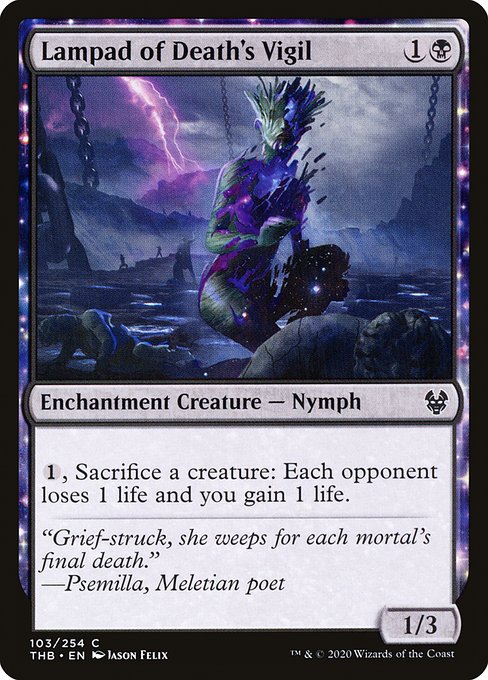
Image courtesy of Scryfall.com
Evolution of MTG Keywords Through the Ages
Magic: The Gathering has grown from a game of stat lines and simple abilities into a sprawling tapestry of words, icons, and interactions. In the earliest sets, a card’s flavor and fate were often decided by a handful of keywords like Flying, First Strike, and Lifelink. As the years stacked, designers introduced new mechanics that felt like small revolutions—keywords that codified specific, repeatable interactions and shaped entire archetypes. 🧙🔥 The expansion of keywords tracks not just what a card does, but how players think about risk, tempo, and board presence. And yet, even in a keyword-rich era, there are cards that remind us the engine isn’t only about vocabulary—it’s about how those words translate into choices at the table. 💎⚔️
A black lens on sacrifice and lifegain
Theros Beyond Death, released in 2020, adds a mythic layer to MTG’s ongoing narrative of life, death, and pacesetting decisions. One example from that set is Lampad of Death's Vigil, a black enchantment creature — Nymph. For a modest {1}{B} mana investment, you get a 1/3 body that slides into a classic Aristocrats-flavored strategy: {1}, Sacrifice a creature: Each opponent loses 1 life and you gain 1 life. Simple on the surface, yet it sits at the crossroads of sacrifice mechanics, life manipulation, and political play. This is where you see the evolution of game design: a card doesn’t need a flashy keyword to be influential; it embodies a recurring human theme—pump life into your side while trimming the life total of the table—through a clean, repeatable action. 🧙🔥
“Grief-struck, she weeps for each mortal's final death.” —Psemilla, Meletian poet
That flavor text isn’t just mood; it’s a window into the historical arc of black’s identity in MTG. Black has long mined the power of sacrifice and life exchange, turning weaknesses into systemic advantages. Lampad’s ability is a timely reminder that keywords aren’t the only tools that shape a deck—costed abilities, once the domain of “activate and pay” design, often drive the tempo and resilience of Aristocrats, Aristocrat-adjacent, and sacrifice-heavy builds. The card’s existence in THB also signals how modern design can weave old-school themes—drain, life swing, and creature sacrifice—into contemporary formats with a streamlined, mana-efficient package. 🎨🎲
The card in context: set, rarity, and playstyle
Lampad of Death's Vigil hails from Therós Beyond Death (THB), a set that leans into mythic storytelling and the color identity of black and blue mythos, while keeping a grounded, creature-focused core. This card’s rarity is common, yet its impact on an entire archetype can be surprisingly meaningful. With a 1/3 on a 2-mana body, Lampad isn’t alarmingly fragile, and its sacrifice trigger can be leveraged with a variety of token strategies or creature recurrences. The absence of a traditional keyword doesn’t limit its influence; instead, it emphasizes decision points—what to sacrifice, when to pull the trigger, and how many times you’ll push life totals in your opponent’s direction. For players who enjoy the modern “sacrifice and value” lane, Lampad provides a sturdy anchor for black’s longstanding proclivity toward life manipulation and resource trade-offs. ⚔️
In practice, this kind of card encourages a broader look at mana curves and creature maintenance. You might pair Lampad with token producers or fodder critters that you’re happy to send into the graveyard for value. The life swing isn’t just a scoreboard tick; it’s a pressure tool that can tilt late-game races and force opponents into suboptimal blocks. In environments like Historic or Pioneer, the card’s straightforward cost and effect can slot into midrange or aristocrat-themed decks, offering a reliable finisher in long games where every small life swing compounds into a win. 🧙🔥
Design, lore, and the art of atmosphere
Jason Felix’s illustration for Lampad of Death's Vigil captures a mournful elegance that fits the Theros world—gloomy beauty, a creature of dark charm and quiet menace. The black frame, the creature-type enchantment aura, and the Meletian poet’s line all contribute to a cohesive sense of history and myth. This is a card that rewards attentive players: it stands up to casual play while inviting deeper appreciation for the lore that threads through THB’s gods, nymphs, and underworld echoes. The artwork reinforces the idea that magic isn’t only about what’s printed on the card, but how that image sits in the player’s memory as the table fills with stories of battles, bargains, and back-channel bargains. 🎨
Value, accessibility, and the collector community
On the collectability front, Lampad is a solid example of a common card with enduring appeal. It’s foil-compatible and appears in multiple printings across eras, which matters for collectors who chase foils or specific borders. The card’s price point remains accessible, making it a friendly entry into Aristocrat-style decks for newer players while still offering a meaningful pick for seasoned collectors who enjoy the THB aesthetic. In MTG Arena and on MTGO, its practical utility—life loss on opponents and life gain for you—resonates with players who appreciate clean, reliable effects that scale across formats. 🧙🔥
For readers who enjoy pairing physical and digital play experiences, consider exploring cards that complement Lampad’s sacrifice theme. Cards that generate value from sacrifice, or that reward you for draining life, can create satisfying loops that feel both familiar and fresh. And if you’re curious about more bits of lore and related cards from THB, you’ll find a tapestry of stories that enrich the experience beyond the battlefield. 💎
Speaking of experiences, if you’re looking to enrich your desk while you brainstorm deck ideas, check out a practical cross-ppromotion: a customizable desk mouse pad that pairs nicely with long drafting sessions or night-long deckbuilding marathons. The product is available here: